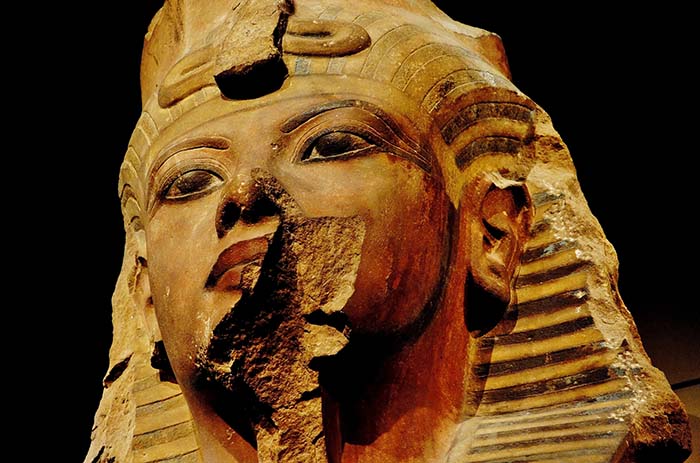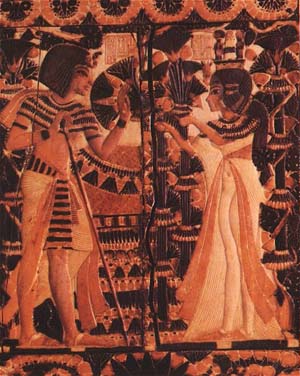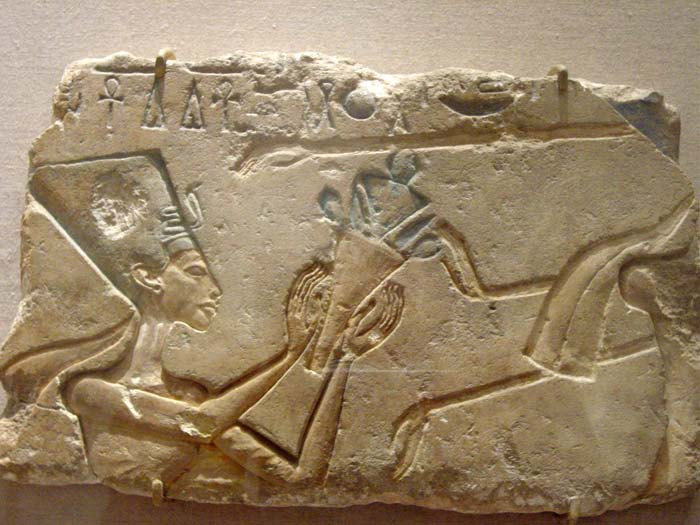King Tut's Family
The family of King Tut is a convoluted mixture of multiple relationships. Tut's wife was also his half-sister, his father was also his uncle, his mother was also his mother-in-law, and so forth. This practice of in-breeding resulted in a high mortality rate at a young age; the average lifespan of an ancient Egyptian was about 30 years.
King Tut, The Boy King
King Tutankhamun, the Boy King, ruled for a mere 10 years but he is arguably the most famous of all the pharaohs. Far from being the slim, athletic young man that he is usually depicted, recent archaeological evidence indicates he had a clubbed left foot, severe malaria, a cleft palate, Koehler's disease, a curved spine, a compromised immune system, and a broken right leg.
King Tut was in considerable pain for most of his short life, and always walked with a cane; the broken leg might have precipitated his death. Evidence has revealed the presence of an infection in the broken leg and Tut's immune system may have been unable to fight it.
Click here to read King Tut's Biography

© sea turtle - Statue of King Tut
Most of these physical deformities may have been the result of decades of incest, which was so popular among ancient Egyptian royalty. Rather than keeping the royal bloodline pure, as the ancient Egyptians thought, incest resulted in defective genes and many deformities.
King Tut's parents were brother and sister, and his wife was his half-sister. The union of Tut and his wife produced only two children, both stillborn girls. Tut's life as pharaoh was tumultuous and filled with intrigue. Although experts now speculate that Tut may have died from malaria, historically, the assumption has been that he was murdered.
King Tut's Wife

© Tiger Cub - King Tut receiving flowers
from Ankhesenamun as a sign of love
Ankhesenamun, Tut's only wife, was also his half-sister and about two years younger than he. Images of her that have survived indicate that she was a beautiful young woman without the deformities and ailments that plagued her brother. Both Ankhesenamun and Tut shared the same father, but Ankhesenamen's mother was the beautiful Queen Nefertiti.
Like Tut, her tumultuous life was very brief and her death is uncertain. She and Tut married when he ascended the throne and were together until his death. After Tut died, Ankhesenamun was informed that she was to marry her grandfather, which was a political move on his part. Ankhesenamun sent a letter to the Hittite King Suppiluliuma I, requesting that he send a son for her to marry because she was afraid of her grandfather.
The Hittite King acceded to her request, sending his son Prince Zannanza to her, but the prince was murdered at the Egyptian border and never reached her. The marriage to her grandfather apparently took place but Ankhesenamun disappeared during his reign, between about 1325 BC and 1321 BC. Since no evidence of her mummy or tomb has ever been found, historians postulate that she was murdered and her body disposed of.
Ankhesenamun was briefly married to her father, King Akhenaten, but no children were produced, and she was married to her father's co-regent, Smenkhkare, for a brief period. She also had a name change during her lifetime, her birth name was Ankhesenpaaten and later it was changed to the more well known Ankhesenamun.

© Asaf Braverman - King Tut and Ankhesenamun
King Tut's Father
Known as Amenhotep IV for the first four years of his reign, King Tut's father became known as Akhenaten, the heretic king, in the fifth year of his reign. He was one of two sons born to Amenhotep III and his Chief Queen Tiye, and assumed the throne after the death of his older brother.

© kairoinfo4u - Statue of Akhenaten
Although little is known of Tut's regard for his father, the ancient Egyptians hated him because he replaced their polytheistic religion with a monotheistic one. His radical religious beliefs were forced upon his subjects through use of the Egyptian army.
All the old gods were destroyed and the capital was moved from Thebes to the new city of Amarna. This disrupted the economy and destroyed businesses.
Under the old religion, the temple priests ran the economy; under the new monotheistic religion, the government was in control.
The consensus among historians is that Akhenaten was so unpopular that he had to abdicate his throne. He died shortly after his abdication and the cause of his death has yet to be determined.
Akhenaten attempted to have children with his three oldest daughters, but one of them died during childbirth.
Click here to learn more about Pharaoh Akhenaten...King Tut's Mother
King Tut's mother was previously believed to be a Mitanni princess named Kiya. However, DNA tests performed recently have refuted that belief and his birth mother is thought to be the "Younger Lady", which is one of the mummies in Akhenaten's tomb.
Kiya was prominent in court activities until shortly before Akhenaten's death and she's often referred to as one of his favorites; her coffin of gilded wood is similar to one of King Tut's. Since his parents were siblings, Tut's mother was also his aunt and his father was also his uncle.
Queen Nefertiti was his step-mother, as well as his mother-in-law. She shared Akhenaten's passion for a monotheistic religion although she was not as unpopular as he was. Her bust, now in a museum in Berlin, is one of the most copied of ancient Egyptian works of art and is famous for its realism.
Nefertiti was called by many titles and some scholars speculate that she briefly ruled Egypt during the period between her husband's death and her son's ascension. She and Akhenaten produced six daughters. Her mummy has not yet been definitively located, although scholars speculate that the mummy of the "Elder Lady" in Akhenaten's tomb is actually the remains of Queen Nefertiti.
Other Family Members

© tutincommon - Depiction of Nefertiti at Amarna
King Tut's family members encompassed many relatives due to his father's many wives. Additional family members include:
- Smenkhkare, brother
- Meritaten, sister
- Neferneferuate Tasherit, sister
- Setepenre, youngest sister
- Neferneferur, next to youngest sister
- Yuya, great grandfather
- Mutemwiya, great grandmother
- Beketaten, aunt
- Nebetah, aunt
- Iset, aunt
- Henuttaneb, aunt
- Sitamun, aunt

